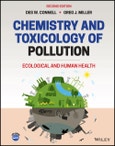Chemistry and Toxicology of Pollution examines the interactions and adverse effects of pollution on both natural ecosystems and human health, addressing chemical, toxicological, and ecological factors at both the regional and global scale. The book is written using a conceptual framework that follows the interaction of a pollutant with the environment from distribution in the various abiotic sectors of the environment to exposure and effects on individuals and ecosystems. The authors also highlight the critical role of various socio-economic, political, and cultural aspects in achieving sustainable goals, strategies, and science-based solutions to pollution and health. This comprehensive volume covers the chemical behavior and governing principles of pollutants, their interactions with humans and ecosystems, and the methods and processes of environmental risk assessment and pollution management.
Extensively revised and expanded, the second edition equips readers with the knowledge required to help lead the way towards a healthy and sustainable future. New chapters address current pollution issues such as global warming and climate change, recent advances in environmental science, the monitoring and evaluation of new and emerging pollutants, risk assessment and remediation, and innovative pollution management approaches and techniques. With in-depth material on human toxicology integrated throughout the text, Chemistry and Toxicology of Pollution: - Provides an effective framework for interpreting the information produced by international, national, and local agencies - Presents unifying theories and principles supported by up-to-date scientific literature - Offers broad coverage of pollution science with an emphasis on North America, the UK, Europe, China, India, and Australia - Discusses the similarities and differences of the impact of pollutants on the natural environment and humans
Chemistry and Toxicology of Pollution, Second Edition enables readers to view pollution in its correct perspective and develop appropriate control measures. It is essential reading for scientists, academic researchers, policymakers, professionals working in industry, and advanced students in need of a clear understanding of the nature and effects of environmental pollution.
Table of Contents
Preface
How to use this book
CHAPTER 1: INTRODUCTION
CHAPTER 2: ENVIRONMENTAL POLLUTANTS
CHAPTER 3: POLLUTANTS, HEALTH, AND ENVIRONMENT
CHAPTER 4: CHEMODYNAMICS OF POLLUTANTS
CHAPTER 5: ENVIRONMENTAL TOXICOLOGY AND ECOTOXICOLOGY
CHAPTER 6: GENETIC TOXICOLOGY AND ENDOCRINE DISRUPTION: ENVIRONMENTAL CHEMICALS
CHAPTER 7: SOME PRINCIPLES OF POLLUTION ECOLOGY AND ECOTOXICOLOGY
CHAPTER 8: POLLUTANTS IN THE OCEANS, ESTUARIES, AND FRESHWATER SYSTEMS
CHAPTER 9: PESTICIDES
CHAPTER10: PETROLEUM, COAL, AND BIOFUELS
CHAPTER11: TOXIC ORGANIC POLLUTANTS
CHAPTER 12: METALS
CHAPTER 13: AIR POLLUTANTS
CHAPTER 14: GREENHOUSE GASES, GLOBAL WARMING, AND CLIMATE CHANGE
CHAPTER15: SOIL AND GOUNDWATER POLLUTION
CHAPTER 16: SOLID, LIQUID, AND HAZARDOUS WASTES
CHAPTER 17: POLLUTION MONITORING AND ASSESSMENT
CHAPTER 18: HUMAN HEALTH AND ECOLOGICAL RISK ASSESSMENT
CHAPTER19: MANAGEMENT OF HAZARDOUS CHEMICALS
CHAPTER 20: POLLUTION: MOVING TOWARD A HEALTHY AND SUSTAINABLE FUTURE
Index








